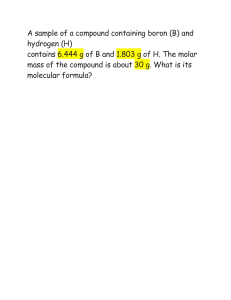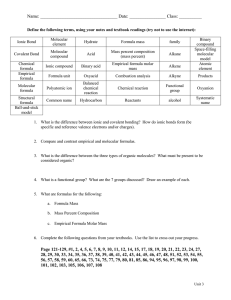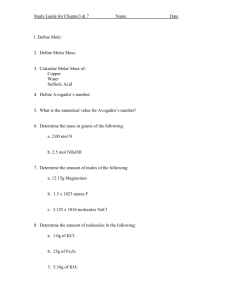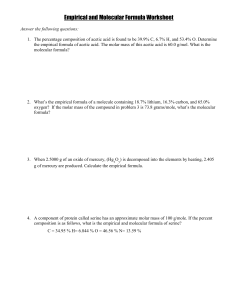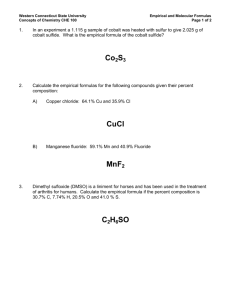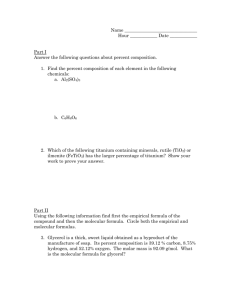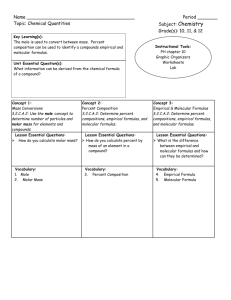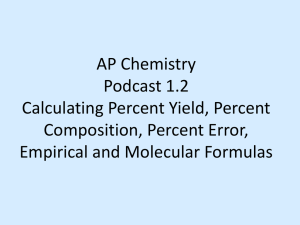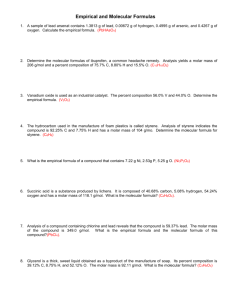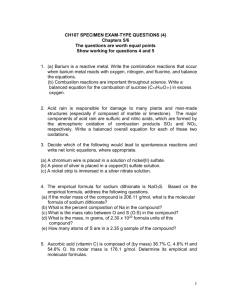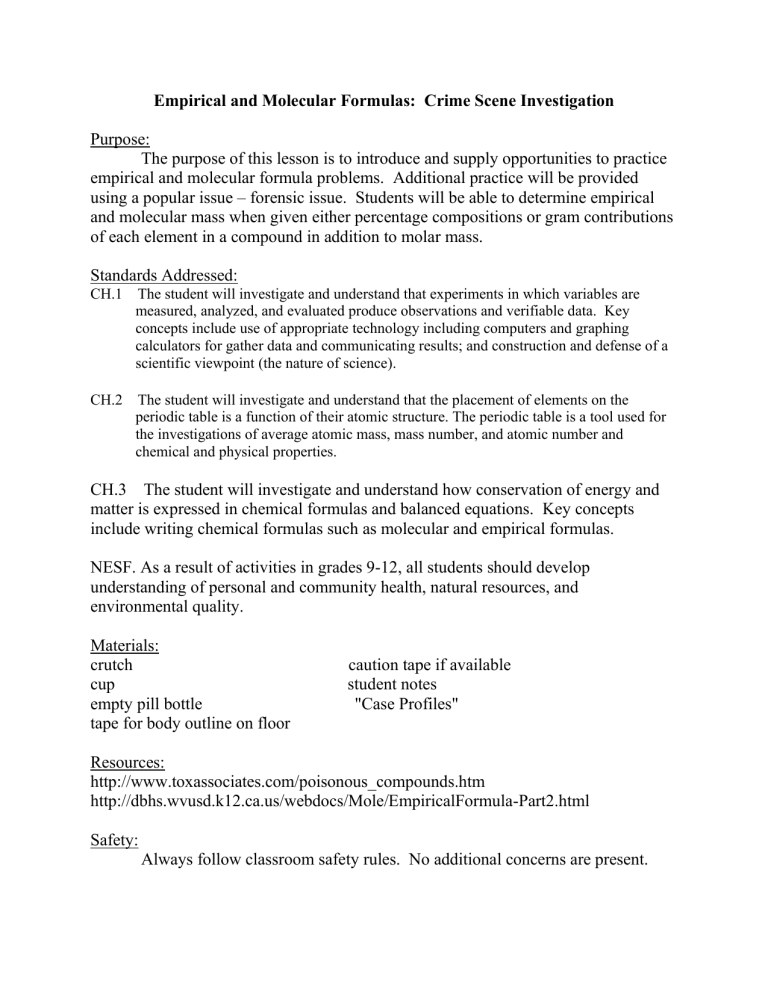
Empirical and Molecular Formulas: Crime Scene Investigation Purpose: The purpose of this lesson is to introduce and supply opportunities to practice empirical and molecular formula problems. Additional practice will be provided using a popular issue – forensic issue. Students will be able to determine empirical and molecular mass when given either percentage compositions or gram contributions of each element in a compound in addition to molar mass. Standards Addressed: CH.1 The student will investigate and understand that experiments in which variables are measured, analyzed, and evaluated produce observations and verifiable data. Key concepts include use of appropriate technology including computers and graphing calculators for gather data and communicating results; and construction and defense of a scientific viewpoint (the nature of science). CH.2 The student will investigate and understand that the placement of elements on the periodic table is a function of their atomic structure. The periodic table is a tool used for the investigations of average atomic mass, mass number, and atomic number and chemical and physical properties. CH.3 The student will investigate and understand how conservation of energy and matter is expressed in chemical formulas and balanced equations. Key concepts include writing chemical formulas such as molecular and empirical formulas. NESF. As a result of activities in grades 9-12, all students should develop understanding of personal and community health, natural resources, and environmental quality. Materials: crutch cup empty pill bottle tape for body outline on floor caution tape if available student notes "Case Profiles" Resources: http://www.toxassociates.com/poisonous_compounds.htm http://dbhs.wvusd.k12.ca.us/webdocs/Mole/EmpiricalFormula-Part2.html Safety: Always follow classroom safety rules. No additional concerns are present. Time: This lesson plan was designed for two 50-minute class periods. Procedure: I. Powerpoint presentation on empirical and molecular formulas. (See EmpiricalMolecularFormulaNotes.ppt) A. What is an empirical formula? 1. Guided example 2. Independent example B. What is a molecular formula? 1. Easy guided example 2. Difficult guided example 3. Independent Example II. Crime Scene Investigation A. Students will be given a "Case Profile" that sets up the scene of the crime and four possible causes of death. Students are to calculate the empirical and molecular formulas for each scenario and then identify the chemical. Once this is completed, they may access the autopsy report for confirmation. B. Students may examine the "crime scene" in the back of the classroom for additional clues. Crime Scene Investigation: Case Profile The victim in the following case is a 35-year old white male named Tony DeMoy. Initial investigators say they found several signs around the death site that suggest foul play. Four possible causes of his untimely death have been suggested by his wife who has been ruled out as a suspect because of a proven alibi. Your task is to identify who and what killed Tony DeMoy. 1. An unlabeled drug bottle was found in the medicine cabinet of DeMoy's bathroom. A 532.99 g sample of the drug was analyzed and found to contain 346.12 g C, 23.98 g H, 108.52 g O, and 54.36 g S. The molar mass of the compound was found to be 314.38 g/mol. It may be a drug prescribed for osteoarthritis. Coincidentally, DeMoy's arthritis has become so intolerable within recent weeks that he's had to rely on the aid of a crutch for mobility. Prolonged ingestion of this drug is thought to lead to heart attack. Demoy's doctor, Finley Finch has a quiet reputation of prescribing dangerous drugs to "dispose of" unwanted patients. Lately,DeMoy has been gaining more recognition in the community due to his latest research on aromatic hydrocarbons. Could Finch's jealousy be the cause of TonyDeMoy's death? 2. Several of DeMoy's full or partial fingerprints were retrieved from a tipped cup found near the crime scene. A faint almond scent was detected around the rim. A 823.15 g liquid sample of the compound was found to contain 3.74% H, 44.43% C, and 51.83% N. The molar mass was determined to be ~27.03 g/mol. A friend of DeMoy's noticed a disgruntled neighbor, Shay Lemarck, uncharacteristically eager to provide refills. Could this be the answer? 3. DeMoy's wife mentioned that the osteoarthritis had become so debilitating as of late that he was "popping painkillers like candy". Certain painkillers are even more dangerous in large quantities than others. One indication that this may be the cause of death was a partially full acetaminophen bottle found on the scene. Chemical analysis of one pill (1454.10 g) revealed 924.08 g C, 87.39 g H, 134.80 g N, and 307.83 g O. The molar mass of the drug is known to be 151.18 g/mol. Could it be that the crime scene is not a crime scene at all? 4. DeMoy's latest and most brilliant research was on a specific type of aromatic hydrocarbon. DeMoy, being a paranoid individual, wouldn't specify which one, but a 453.28 g sample was shown to contain only carbon and hydrogen. Hydrogen contributed 7.76 % of the total mass and the molar mass was determined to be ~78.12 g/mol. The laboratory had a carefully regulated air flow to prevent high-level inhalation. DeMoy periodically mentioned to his wife that he suspected his lab partner, Kasey Hatterson, was altering the flow rates. Curiously, without DeMoy, the published research could mean thousands of dollars for Hatterson. With money as motive, could this solve the mystery? When you have calculated the empirical and molecular formulas for each scenario and identified each substance, you may access the autopsy report to confirm the cause of death. Who, if anyone, killed Tony DeMoy? Name __________________________ Period _________ Date _______ Empirical and Molecular Formula Notes Empirical Formula A formula that gives the simplest whole-number ratio of the atoms of each element in a compound. Chemical Formula (Molecular Formula) H2O2 C6H12O6 CH3O CH3OOCH = C2H4O2 Empirical Formula HO Determining Empirical Formulas Steps: 1. Find mole amounts. 2. Divide each mole by the smallest mole. Rhyme: Percent to mass Mass to mole Divide by small Multiply 'til whole Determine the empirical formula for a compound containing 2.128 g Cl and 1.203 g Ca. A compound weighing 298.12 g consists of 72.2% magnesium and 27.8% nitrogen by mass. What is the empirical formula? Molecular Formula The formula that gives the actual number of atoms of each element in a compound. Determining Molecular Formulas Steps: 1. Find the empirical formula. 2. Calculate the Empirical Formula Mass. 3. Divide the molar mass by the “EFM”. 4. Multiply empirical formula by the factor. Find the molecular formula for a compound whose molar mass is ~124.06 and empirical formula is CH2O3. Find the molecular formula for a compound that contains 4.90 g N and 11.2 g O. The molar mass of the compound is 92.0 g/mol. Putting EVERYTHING together A 528.39 g compound containing only carbon, hydrogen, and oxygen is found to be 48.38% carbon and 8.12% hydrogen by mass. The molar mass of this compound is known to be ~222.25 g/mol. What is its molecular formula? Autopsy Report Tony DeMoy Autopsy Report or Clues at Crime Scene 1.) It is not the substance whose sum of the subscripts on the molecule or formula is 20. 2.) It is not the substance whose sum of the subscripts on the molecular formula divided by the subscript on oxygen is 9. 3.) It is not the substance whose empirical and molecular formulas are different. He had high levels of Rofecoxib in his blood. Explain what killed Tony DeMoy.
